The lineout will be a vital foundation and a potential source of tries for England as they look to overturn the Wallabies this month
Back in January on selecting their first England squad, Eddie Jones and Steve Borthwick stressed the importance of set-piece variation. As well as reasserting their team’s traditional muscle, they wanted players to view each scrum and lineout as a platform to play off.
During the Six Nations, there were signs of progress. Rather than attempting to bully penalties in a blinkered manner, the Grand Slam champions made use of front-foot possession. Anthony Watson’s try in Paris, which came one phase after Billy Vunipola had picked and gone from an advancing scrum, epitomised this.
On the way to a 27-13 victory over Wales on May 29 at Twickenham, the hosts returned 18 clean takes from 18 lineouts. Crucially, they used that ball intelligently and incisively – much in the same way that Japan did throughout the World Cup. Here is a closer look.
Blindside dart
From their very first throw, England caused Wales difficulty at the lineout. We begin before two minutes have elapsed and the operation looks very slick.
Dylan Hartley finds Joe Launchbury, who is hoisted by a fine lift from fellow lock Courtney Lawes.
Teimana Harrison, standing in the position conventionally occupied by a scrum-half, moves in to take the ball as Matt Mullan arcs around from the tail to lend his weight to the maul:
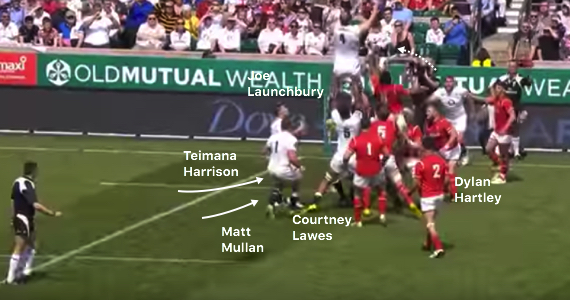
From here, with the lineout called over, scrum-half Ben Youngs and blindside wing Watson approach a drive that is nudging forward. Note that Rhys Webb and Scott Baldwin are positioned on either fringe:
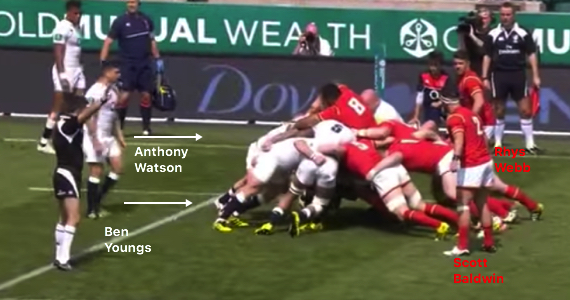
Peering over the maul, Youngs scopes out a 10-metre channel. Webb, alert to the intentions of his opposite number, calls Baldwin across to help out:
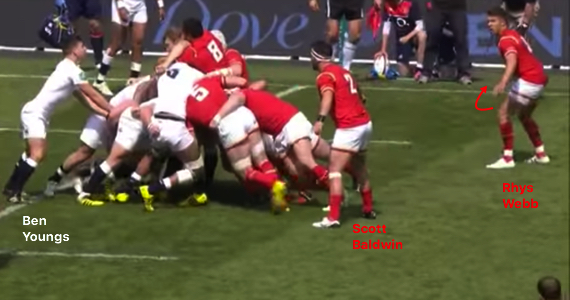
Nevertheless, Youngs backs himself and Watson in a two-on-two situation.
Leicester Tigers practise this a great deal in training. Sure enough, Youngs does brilliantly. He aims for Baldwin’s outside shoulder, forcing the hooker to strain in pursuit of him.
This encourages Watson to cut back against the grain:
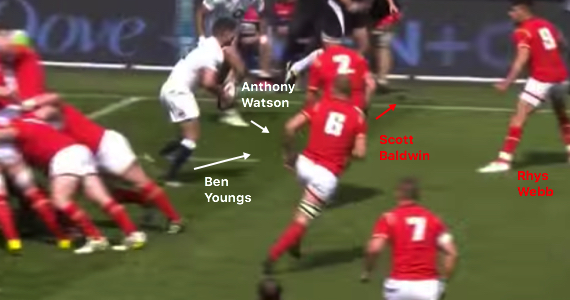
Rather than leave Youngs to Webb and cover the switch line, Baldwin commits to the tackle. When Youngs drops off a pass to Watson, the Bath man has a bit of room:

He can step past Ross Moriarty and Dan Lydiate…
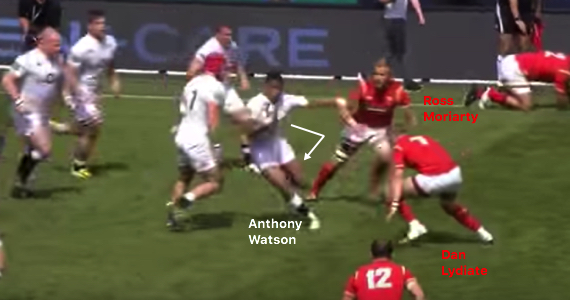
…before drawing Jamie Roberts…
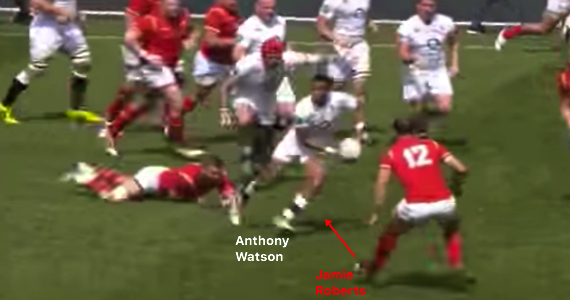
…and releasing George Ford, who has followed up in support with a vast expanse of open field to his right:
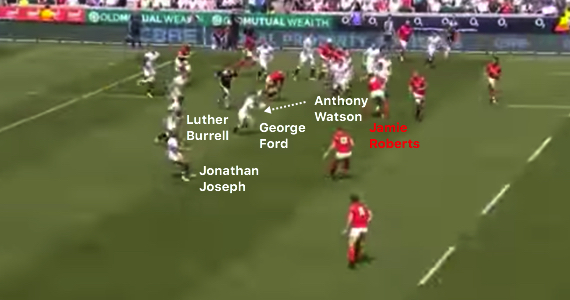
A clever grubber from Jonathan Joseph turned Wales and soon England had another lineout in a far more dangerous position.
Yarde warning
Marland Yarde is a sizeable specimen. He is a direct, strong carrier that can punch holes from first phase. England’s backline lacked this option during the Six Nations.
When explaining Yarde’s inclusion at the expense of in-form Chris Ashton, Jones referenced this try – from a lineout – in New Zealand two years ago:

Yarde was on the right wing against Wales and England attempted to bring him in straightaway. Youngs comes up behind a driving maul with Baldwin and Webb in identical defensive positions:
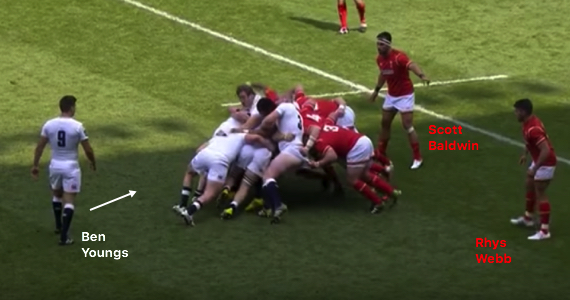
Clearly concerned, Baldwin beckons the openside defence to move up as Youngs glances towards the blindside:
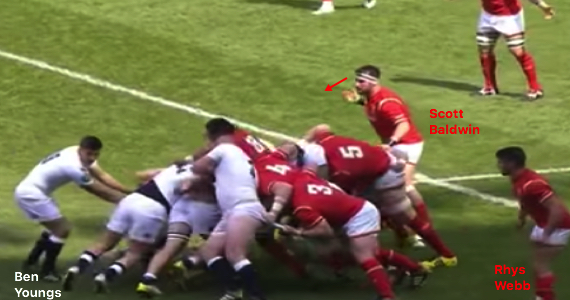
Reacting to his scrum-half, Yarde careers from left to right but stops because the ball is caught up in the maul:
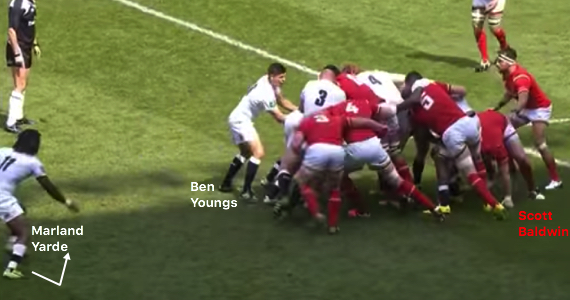
The Harlequin then curves back on to the openside. Unfortunately for England though, Taulupe Faletau fights through the drive…
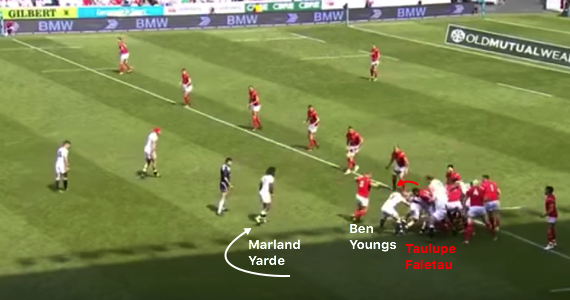
…and claws the ball out of Youngs’ grasp before Yarde can be unleashed:
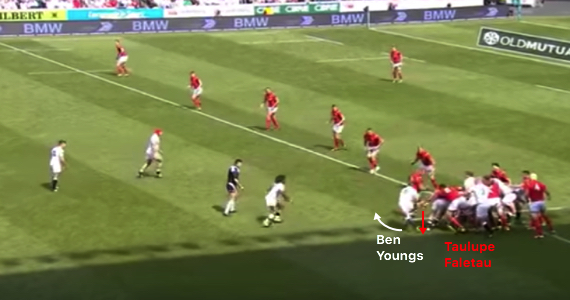
Borthwick, a stickler for detail, would have been annoyed at how Faletau was allowed to disrupt. On the back of this intervention, Wales escaped and built up a 10-0 lead. However, England hit back at the end of the first quarter.
Burrell’s centre surge
As Jones seeks to puncture the gainline and generate quick ruck ball, abrasive Ben Te’o may make a Test debut in Brisbane.
Luther Burrell fulfilled that role against Wales and, within close range of the try-line here, his power proved irresistible. Again, Hartley’s skills are vital. He hits his man, Mullan lifting the resourceful Jack Clifford:
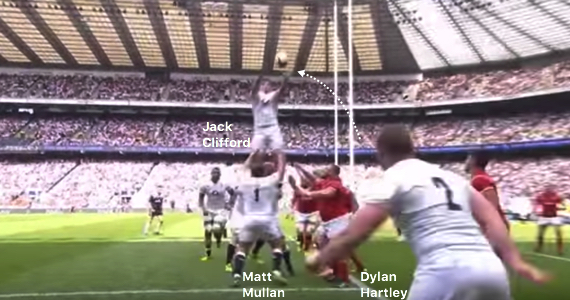
Borthwick’s meticulous drilling is apparent as another sturdy maul is formed. Interestingly, Yarde joins the drive rather than offering himself as a runner:
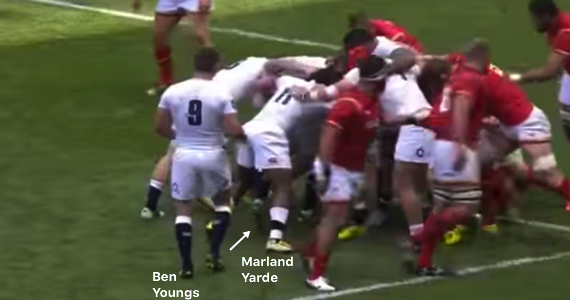
Now, many spectators grow unduly irritated when Youngs runs laterally before linking with runners. Here though, the merits of such play are obvious.
As Youngs arcs on to the openside from the maul, attacking the space between the first and second defender, the Welsh line is cautious and passive.
Clearly worried that Moriarty will be beaten on the outside, Dan Biggar is fixed on England’s scrum-half. Meanwhile, with Ford as an option out of the back and Joseph following up, Burrell aims at the space to Biggar’s right – a blind-spot for the fly-half. Roberts’ body position speaks volumes:
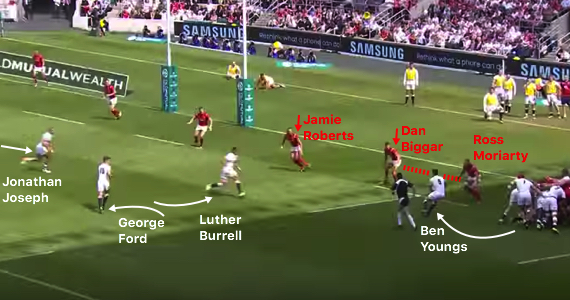
An aerial view of the moment Youngs releases his pass accentuates the predicament Biggar is in. He is flat-footed and in no position to stop Burrell’s clever angle, which curves away to his right:
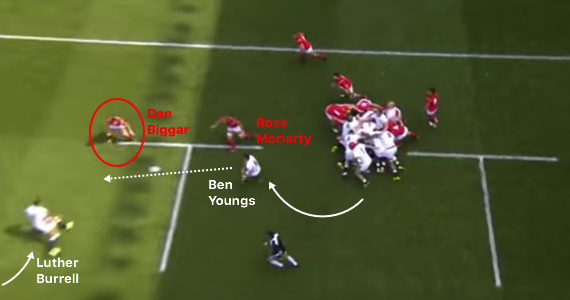
Though Biggar turns back on himself to make contact with Burrell six metres out…
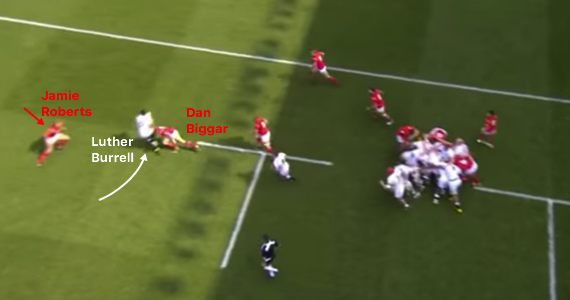
…the Northampton Saints centre surges through the unbalanced tackler, stretches out and finishes:
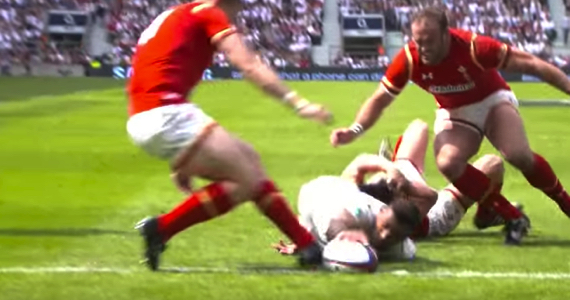
This score demonstrates the value of a larger, more physical midfielder. It also stresses the launchpad that the lineout can provide.
Transferrable skills
Last week, World Rugby announced that the June Tests would be played under a new law amendment that has been in place in the southern hemisphere since January 1. The tweak concerns the maul and is outlined below:

Watch carefully this clip, from Wales’ 19-10 defeat of France in February. France hooker and captain Guilhem Guirado is passed the ball at the rear of the maul. This first transfer is completely legal.
As Guirado reaches for the ball though, he finds himself close to Lydiate. Scrum-half Maxime Machenaud tugs his skipper by the shirt and Guirado slides towards the back foot of the maul:

Because Guirado remains attached the whole time, there was no sanction under the previous laws. Following the recent update, this same play would now result in a penalty to Wales.
Super Rugby sides have combated these laws by feigning to set up a maul, drawing in opposition forwards, before rapidly moving the ball away. Watch how England employ the same tactics here.
From a shortened, four-man lineout, Harrison is again standing at scrum-half. Baldwin is at the tail of Wales’ lineout. England will look to exploit him:

First though, Lawes and Clifford switch places, the former dummying…
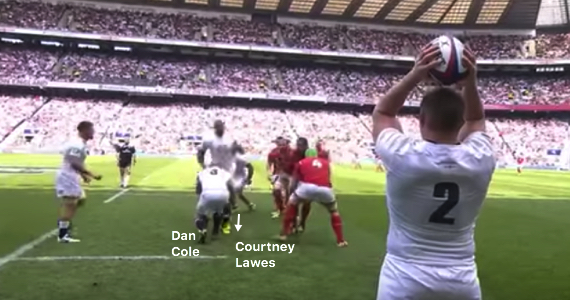
…before Launchbury circles around from the back to take Hartley’s pinpoint throw.
Harrison moves in from scrum-half as Launchbury lands. It is a copybook means of setting up a lineout drive…
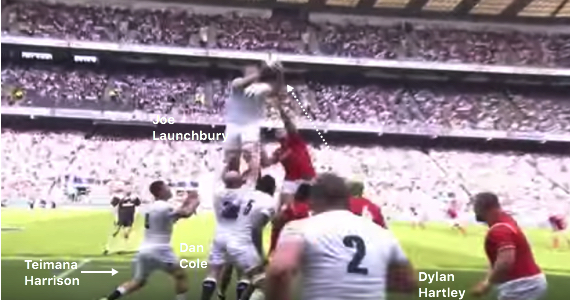
…but instead, Harrison pulls the ball clear…

…and passes to Youngs…

…who has the option of hitting either James Haskell or Yarde after drawing Baldwin. On this occasion, he chooses Haskell and his burly back-rower can career over the gainline:
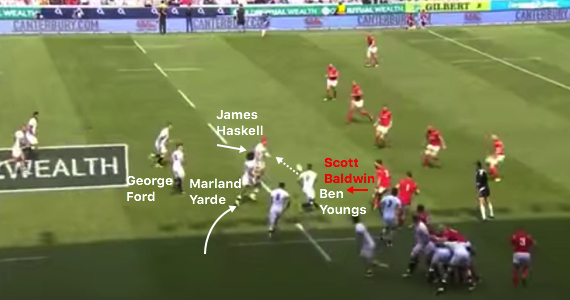
Later in the first half though, England run a very similar move only to use a different carrier. Harrison stands at scrum-half…
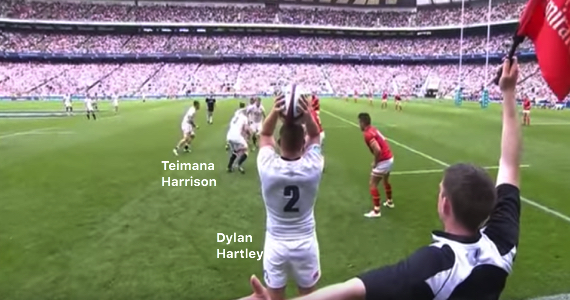
…watching as Lawes climbs…
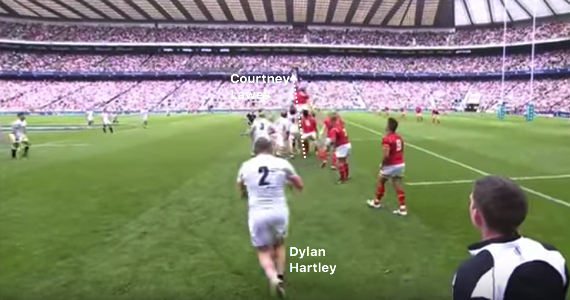
…and feeding Youngs. Again, as Baldwin is isolated, England have runners in motion. Yarde sprints around, Haskell comes from out to in and Ford waits in a second wave as the link to the outside backs:
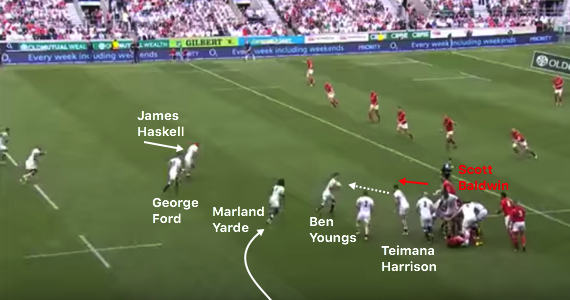
Youngs runs beyond the gainline to the verge of the 22, cutting off Baldwin before shipping to Yarde…
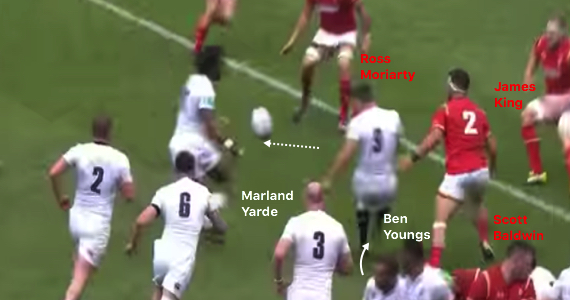
…who stays strong in the tackle of James King and Moriarty to set a target for supporting forwards Haskell, Hartley and Harrison:
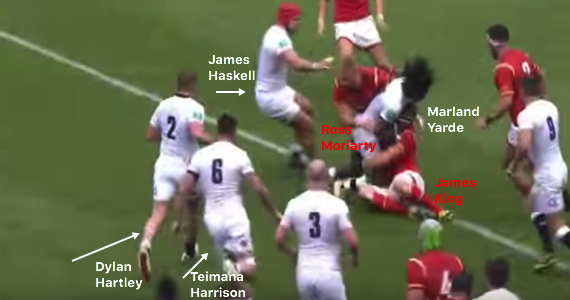
In Australia this weekend, Billy Vunipola’s considerable frame will contribute to more chaos off the back of these intricate lineout moves.
Getting clever
Still trailing 13-10 at half-time, England needed a boost early in the second period. Once more, the lineout provided a foothold from which to mount some pressure. Harrison moves in from scrum-half…
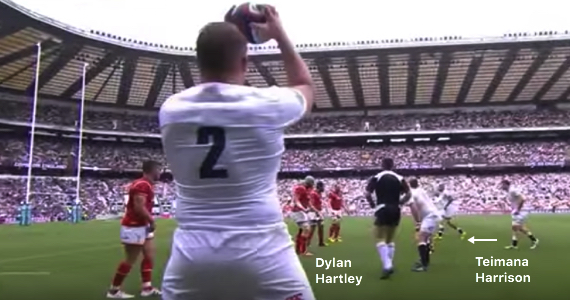
…ripping away to feed Youngs.
As Harrison passes, look at the respective positions of Wales’ four closest defenders. Webb is on the blindside. Ten metres away from the lineout, Moriarty and King are desperately trying to cut down the space in front of them. Baldwin (circled) is the man that England try to manipulate:

Youngs heads right into midfield, dragging Baldwin with him. Meanwhile, blindside wing Watson speeds on to Youngs’ left shoulder to receive an inside pass.
By this point, both Webb and King have seen the danger. Instead of pushing up, they shift into reverse gear:
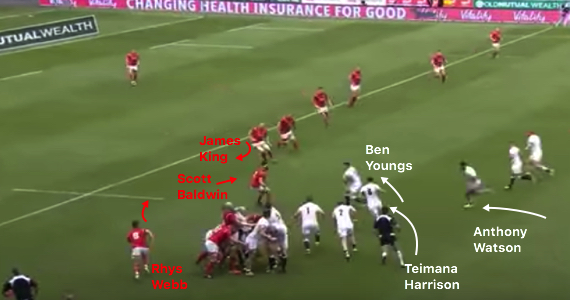
Although this strike move manoeuvres the Wales defence perfectly, opening up a gaping hole to Baldwin’s right, Watson is slightly too late to reach Youngs’ flick…

…fortunately for the hosts though, tireless Harrison has followed his pass and gathers the ball before surging over the 22:
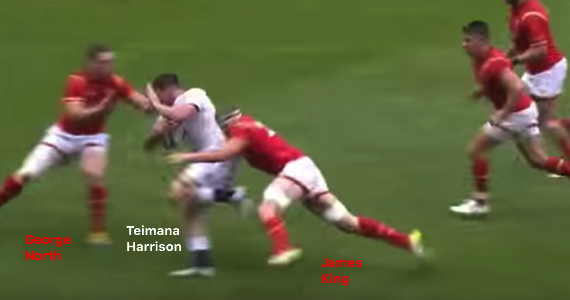
Within minutes, England were in front.
Breaking the dam
Six years ago in Sydney, Young scorched over for a phenomenal solo try after receiving the ball from a lineout. Australia have been wary of him ever since, and the 26 year-old sounded a timely warning of his sniping prowess against Wales.
Harrison is the initial scrum-half again…

…turning away from the faux-maul and hitting Youngs once Hartley’s throw has been taken. Panning out, we can see the flurry of activity in front of Baldwin:
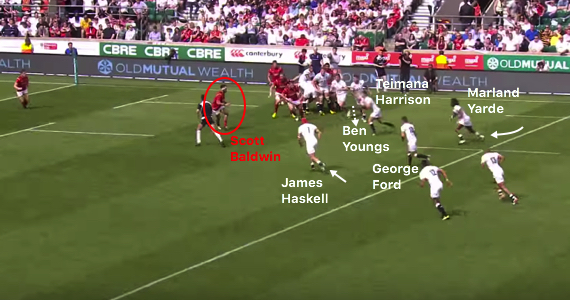
Another view shows us Rob Evans, struggling to make it across as Yarde looks to emerge from behind Youngs’ left shoulder and Haskell charges on a narrow line:
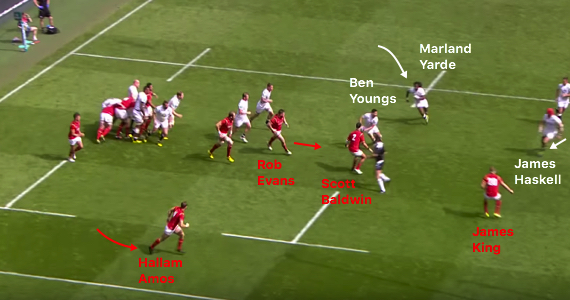
Youngs throws a dummy, which Baldwin buys, and steps through…
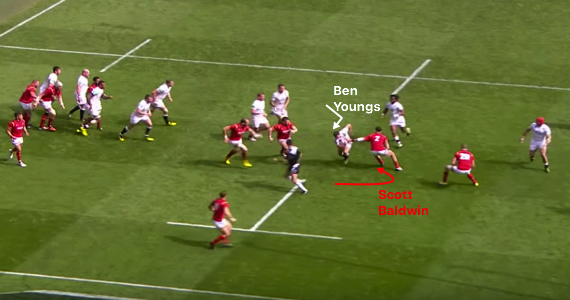
…winning the collision with Hallam Amos…
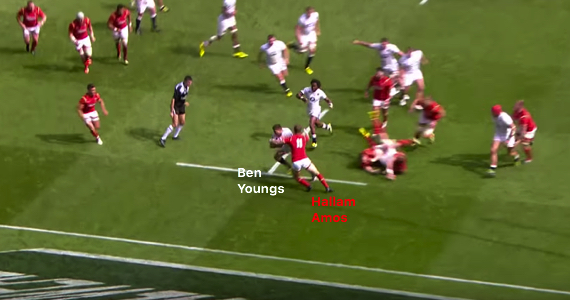
…and dotting down:
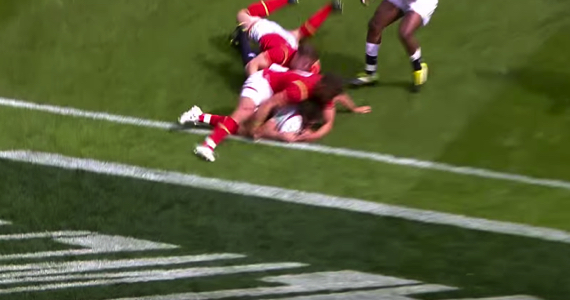
As with so many tries, this one comes as a cumulative reward for continued pressure and patience.
This was the fourth or fifth time that England drew in Wales’ forwards with a faux-maul before moving the ball clear, isolating Baldwin at the tail and forcing him to make a decision. Here, the hooker drifted off Youngs too early and paid the price.
England’s key decision-makers – half-backs and those calling the lineout – should be praised for their grasp of field position too. The faux-maul was always used beyond the opposition 10-metre line. Around the halfway line, England went straight off the top and in their own half, a conventional maul was used. There seemed to be a growing awareness of game situations and how to adapt to them.
Same hymn sheet
For any coach, cohesion is one of the the most satisfying qualities to witness. With that in mind, Borthwick and Jones would have been delighted with the manner in which England’s replacements slotted seamlessly into the same lineout systems.
Not long after joining the fray, Danny Care conducted the same switch for Watson that Youngs had attempted previously. Then, with five minutes to go, came this drive.
Tommy Taylor throws long to Dave Attwood. Matt Kvesic, taking over Harrison’s role, moves in from scrum-half to clasp on to the ball and instigate a drive that takes England to the verge of Wales’ 22:

The maul has crabbed to the right, presenting Care with options either side:
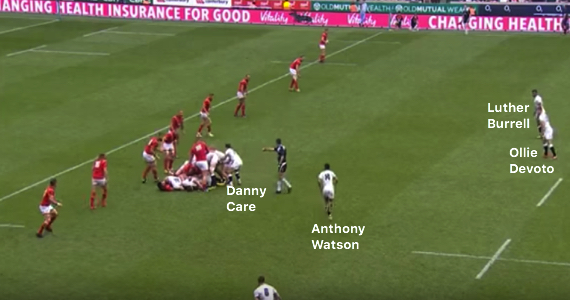
But he is decisive and opts to go right, calling over Watson…
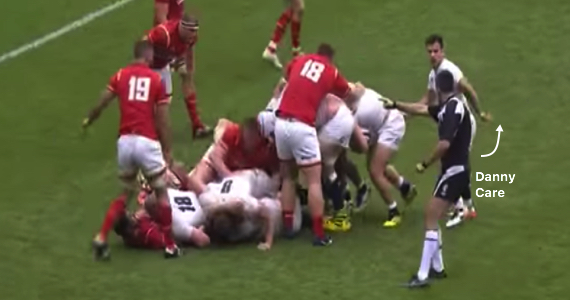
…and setting off, on the same arc that Youngs took in the first half, with Watson as a trail runner holding fringe defenders and Burrell as a more direct midfield option.
Care’s snipe, with potential carriers buzzing off him, stunts Wales’ line-speed…
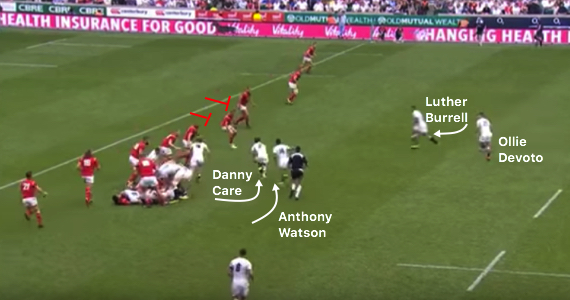
…so when Ollie Devoto receives a pass behind Burrell, he has plenty of space:

The ease and effectiveness with which replacements slot into these moves as they come on to the pitch underlines the strength of England’s approach and the clarity of their coaching.
Whoever starts at Suncorp Stadium on Saturday will be well-versed in Jones’ plans to take down the Wallabies. And the lineout is sure to be a fundamental part of his thinking.





